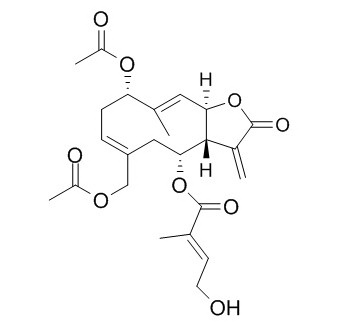Eupalinolide A
Eupalinolide A and Eupalinolide B induce the expression of HSP70 via the activation of HSF1 by inhibiting the interaction between HSF1 and HSP90. They could be beneficial for use in cosmetics and medicines as a consequence of their inhibitory action on UV-induced skin damage and melanin production.
Inquire / Order:
manager@chemfaces.com
Technical Inquiries:
service@chemfaces.com
Tel:
+86-27-84237783
Fax:
+86-27-84254680
Address:
1 Building, No. 83, CheCheng Rd., Wuhan Economic and Technological Development Zone, Wuhan, Hubei 430056, PRC
Providing storage is as stated on the product vial and the vial is kept tightly sealed, the product can be stored for up to
24 months(2-8C).
Wherever possible, you should prepare and use solutions on the same day. However, if you need to make up stock solutions in advance, we recommend that you store the solution as aliquots in tightly sealed vials at -20C. Generally, these will be useable for up to two weeks. Before use, and prior to opening the vial we recommend that you allow your product to equilibrate to room temperature for at least 1 hour.
Need more advice on solubility, usage and handling? Please email to: service@chemfaces.com
The packaging of the product may have turned upside down during transportation, resulting in the natural compounds adhering to the neck or cap of the vial. take the vial out of its packaging and gently shake to let the compounds fall to the bottom of the vial. for liquid products, centrifuge at 200-500 RPM to gather the liquid at the bottom of the vial. try to avoid loss or contamination during handling.
J Korean Soc Food Sci Nutr2020, doi: 10.3746.
Mol Biol Rep.2023, 50(5):4029-4038.
Chin J Appl. Physiol.2019, 35(3):283-288
Int J Mol Sci.2021, 22(19):10405.
Rev. Chim.2020, 71(3),558-564
Research Square2023, 2883170.
Patanjali Research Foundation2024, ssrn.4807357
Eur J Pharmacol.2024, 978:176800.
Nutr Res Pract.2023, 17(4):670-681.
Appl Microbiol Biotechnol.2024, 108(1):207.
Related and Featured Products
Biochem Pharmacol. 2012 Apr 1;83(7):909-22.
Purification and characterization of HSP-inducers from Eupatorium lindleyanum.[Pubmed:
22245466]
The expression of heat shock proteins (HSPs), particularly HSP70, provides resistance to stressors. We recently reported that ultraviolet (UV)-induced melanin production and skin damage were suppressed in transgenic mice expressing HSP70 and that an extract of Eupatorium lindleyanum induces the expression of HSP70 in cells.
METHODS AND RESULTS:
Here we report the purification of Eupalinolide A and B (EA and EB) from E. lindleyanum, and describe their actions as HSP-inducers. Eupalinolide A and EB both induced the expression of HSP70 in cells at concentrations that did not significantly affect cell viability. Treatment of cells with Eupalinolide A or EB activated heat shock factor 1 (HSF1), while the artificial suppression of HSF1 expression diminished the Eupalinolide A - or EB-mediated induction of HSP70 expression. Furthermore, EB inhibited the interaction between HSF1 and HSP90, which is known to inhibit the activity of HSF1. These findings suggest that Eupalinolide A and EB induce the expression of HSP70 via the activation of HSF1 by inhibiting the interaction between HSF1 and HSP90. Eupalinolide A and EB both induced the expression of HSP70 synergistically with other stressors. Furthermore, pre-treatment of cells with Eupalinolide A or EB suppressed melanin production and stressor-induced apoptosis. These effects were suppressed by the artificial suppression of HSP70 expression. In vivo, the percutaneous administration of EB induced the expression of HSP70 and suppressed UVB radiation-induced damage, inflammatory responses and melanin production in the skin.
CONCLUSIONS:
These results suggest that Eupalinolide A and EB could be beneficial for use in cosmetics and medicines as a consequence of their inhibitory action on UV-induced skin damage and melanin production.
J Chromatogr B Analyt Technol Biomed Life Sci. 2015 May 16;995-996C:1-7.
Pharmacokinetics of eupalinolide A, eupalinolide B and hyperoside from Eupatorium lindleyanum in rats by LC/MS/MS.[Pubmed:
26011510]
A simple, selective, and sensitive LC/MS/MS method was developed and validated for simultaneous determination of Eupalinolide A, eupalinolide B, and hyperoside in rat plasma. Plasma samples were processed by protein precipitation with acetonitrile.
METHODS AND RESULTS:
The three analytes, together with internal standard (IS, lysionotin), were separated on a Venusil MP-C18 column (50mm×2.1mm, 3μm) using a mobile phase of methanol and 10mM ammonium acetate (45:55, v/v) with isocratic elution. Mass spectrometric detection was performed by multiple-reaction monitoring mode via electrospray ionization source. Linear calibration curves were obtained for the following concentration range: 1.28-640ng/mL for Eupalinolide A; 1.98-990ng/mL for EB; and 2.00-1000ng/mL for HYP. The intra- and inter-day precision was less than 10.25%, and the accuracy was between 89.16% and 110.63%. The extraction recovery of the analytes and IS from rat plasma was above 88.75%.
CONCLUSIONS:
The validated method has been successfully applied to pharmacokinetic studies of the three analytes following intragastric administration of Eupatorium lindleyanum extract at a single dose of 100, 250, and 625mg/kg to Sprague-Dawley rats, respectively. The pharmacokinetic results may help to better understand the pharmacological actions of the herb E. lindleyanum.



